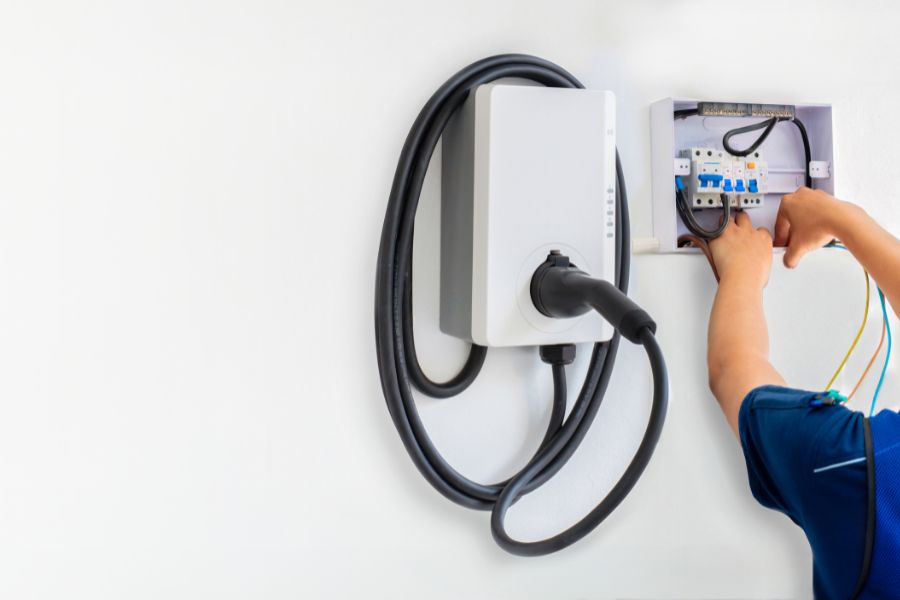
To install a commercial EV charging station, start by assessing the site for space and power needs. Upgrade your electrical system for high amperage capacity. Obtain permits and ensure ADA compliance. Choose a station model that matches power requirements and connector type. Test for functionality and schedule regular maintenance. Each step is critical in ensuring a successful installation.
Site Assessment and Planning
When assessing and planning for the installation of a commercial EV charging station, ensure that the site is suitable for accommodating the necessary electrical infrastructure and equipment. Begin by evaluating the location to determine if it has adequate space for the charging stations, parking spots, and any required signage. Consider factors such as accessibility for users, visibility, and proximity to power sources. Conduct a thorough inspection of the electrical system to assess its capacity and compatibility with the charging station requirements. Identify the main electrical panel and determine if it can support the additional load of the charging equipment. Check for any potential upgrades needed to meet the power demands of the EV chargers. Additionally, analyze the site layout to plan the most efficient placement of the charging stations and ensure proper cable routing to connect them to the electrical supply. By carefully assessing and planning for these crucial elements, you can ensure a successful installation of a commercial EV charging station.
Electrical System Upgrades
Consider upgrading your electrical system to ensure it can meet the power demands of the commercial EV charging station installation. To begin, assess your current electrical capacity by consulting with a qualified electrician. The charging station will require a dedicated circuit with a high amperage capacity, potentially necessitating upgrades to your electrical panel and wiring.
Upgrading to a three-phase power supply may be beneficial for faster charging speeds and increased efficiency. This involves installing a new transformer and modifying your electrical distribution system. Additionally, consider implementing smart charging technology to optimize energy consumption and cost-effectiveness.
Ensure that the electrical upgrades comply with local building codes and safety regulations. It is crucial to work with a certified electrician experienced in commercial installations to guarantee the system’s reliability and safety. By proactively upgrading your electrical system, you can accommodate the power requirements of the EV charging station and ensure seamless operation for your customers.
Permitting and Regulatory Compliance
Assess the regulatory requirements and obtain necessary permits before proceeding with the installation of a commercial EV charging station to ensure compliance with local codes and regulations. Compliance with local regulations is crucial to avoid potential fines and delays in the installation process. Contact your local building department or planning office to determine the specific codes and permits needed for your project. Common requirements may include electrical permits, building permits, zoning approvals, and environmental assessments.
Additionally, familiarize yourself with the Americans with Disabilities Act (ADA) guidelines to ensure that your charging station meets accessibility requirements. Compliance with ADA standards is essential for accommodating all users, including those with disabilities. Consider factors such as accessible parking spaces, signage, and route accessibility when designing the layout of your charging station.
Charging Station Selection and Installation
For optimal performance and efficiency, select a charging station model that aligns with your power needs and installation requirements. Consider factors such as power output, connector type, and networking capabilities when choosing a charging station. The power output of the charging station should match the electrical capacity of your building to ensure fast and reliable charging. Additionally, select a connector type that is compatible with the electric vehicles in your fleet to avoid compatibility issues.
When installing the charging station, ensure it is placed in a convenient location with proper access to power sources. Conduct a site survey to assess the electrical infrastructure and determine the best location for installation. Consider factors such as cable routing, distance from parking spaces, and accessibility for maintenance.
Follow the manufacturer’s installation guidelines and consult with a qualified electrician to ensure proper wiring and grounding. Consider implementing smart charging features and networking capabilities to monitor usage, manage billing, and optimize charging schedules. By selecting the right charging station and following installation best practices, you can ensure a seamless charging experience for your electric vehicle fleet.
Testing and Maintenance
To ensure the ongoing functionality and longevity of your electric vehicle charging station, regular testing and maintenance procedures must be diligently followed. Periodic inspections should be conducted to check for any signs of wear and tear, loose connections, or other potential issues. It is crucial to test the charging station’s functionality, including the charging speed and compatibility with different vehicles, to ensure optimal performance.
Maintenance tasks should include cleaning the charging connectors to prevent corrosion, inspecting the cable insulation for any damage, and ensuring that the station’s software is up to date. Regularly checking the electrical components for overheating and monitoring the station’s energy consumption can help prevent potential malfunctions and ensure safe operation.
Additionally, it is recommended to have a professional electrician perform routine maintenance checks at least once a year to identify any underlying issues and address them promptly. By following these testing and maintenance procedures, you can maximize the efficiency and reliability of your commercial EV charging station.







